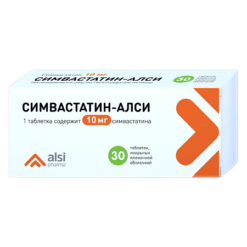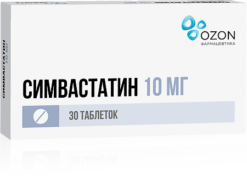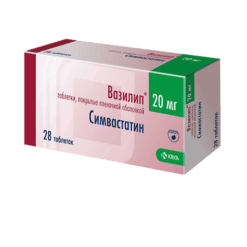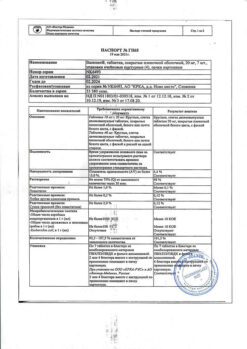No products in the cart.
Simvastatin Alkaloid, 20 mg 28 pcs
€1.00
Out of stock
(E-mail when Stock is available)
Description
Hypolipidemic drug from the group of statins, HMG-CoA reductase inhibitor. It is a prodrug because it has in its structure a closed lactone ring, which is hydrolyzed after entering the body.
The lactone ring of statins is similar in structure to the part of the HMG-CoA reductase enzyme. By the principle of competitive antagonism, the statin molecule binds to the part of the coenzyme A receptor where this enzyme is attached. The other part of the statin molecule inhibits the conversion of hydroxymethylglutarate into mevalonate, an intermediate product in the synthesis of the cholesterol molecule. Inhibition of HMG-CoA reductase activity leads to a series of sequential reactions resulting in a decrease of intracellular cholesterol content and a compensatory increase of LDL-receptor activity and corresponding acceleration of LDL cholesterol (Xc) catabolism.
The hypolipidemic effect of statins is associated with a decrease in total Xc levels at the expense of LDL Xc. The decrease in LDL levels is dose-dependent and is exponential rather than linear.
The statins do not affect the activity of lipoprotein and hepatic lipases and have no significant effect on the synthesis and catabolism of free fatty acids, so their effect on TG levels is secondary and mediated through their main effects on reducing LDL-C levels. A moderate decrease in TG levels with statin treatment appears to be due to the expression of remnant (apo E) receptors on the surface of hepatocytes involved in catabolism of LDL, which includes approximately 30% of TG.
According to controlled studies, simvastatin increases HDL-C levels by up to 14%.
In addition to hypolipidemic action, statins have a positive effect in endothelial dysfunction (preclinical sign of early atherosclerosis), on the vascular wall, atheroma condition, improve rheological properties of blood, have antioxidant, antiproliferative properties. There is evidence that simvastatin improves endothelial function already after 30 days of therapy.
The use of simvastatin was accompanied by a decrease in the incidence of cardiovascular disorders regardless of the baseline level of CH-LDL.
Indications
Indications
Active ingredient
Active ingredient
Composition
Composition
Interaction
Interaction
Concomitant use increases the effect of indirect anticoagulants (including warfarin).
Concomitant use with cytostatics, itraconazole, fibrates, nicotinic acid in high doses, immunosuppressants increases the risk of myopathy.
Concomitant use with digoxin increases plasma concentrations of digoxin.
A case of development of rhabdomyolysis symptoms after a single dose of sildenafil in a patient receiving simvastatin has been described.
Special Instructions
Special Instructions
Symvastatin is used with caution in patients with liver disease, with chronic alcoholism, with arterial hypotension, decreased or increased skeletal muscle tone of unclear etiology, with epilepsy, severe renal failure.
Liver function monitoring is necessary before and during treatment.
In patients receiving anticoagulants of coumarin derivatives the prothrombin time should be monitored before and during treatment with simvastatin.
The use of simvastatin should be discontinued if there is a significant increase in CPK activity or suspected myopathy, if acute or severe disease develops, if any risk factor predisposes to renal failure due to rhabdomyolysis appears.
It is not recommended to use simvastatin concomitantly with immunosuppressants, fibrates, nicotinic acid (in doses that cause hypolipidemia), antifungal drugs with azole derivatives.
Pediatric use
The safety and effectiveness of simvastatin in pediatric practice have not been established. It is not recommended for use in children.
Features
Features
After oral administration simvastatin is well absorbed from the gastrointestinal tract (on average 85%). Cmax is reached in 4 hours.
The pharmacokinetic parameters of simvastatin are not affected by taking immediately before a low-fat meal.
On “first passage” through the liver simvastatin is biotransformed to form active beta-metabolites. Binding to plasma proteins is 95%.
The concentration of active simvastatin metabolite in human systemic blood flow is less than 5%.
It is excreted unchanged and as metabolites, mainly in the bile – 60-85%; 10-15% – as inactive metabolites are excreted by the kidneys.
Contraindications
Contraindications
Side effects
Side effects
Digestive system disorders: constipation, diarrhea, loss of appetite, flatulence, nausea, abdominal pain, pancreatitis, increased ALT, AST, GGT, ALP activity.
CNS and peripheral nervous system disorders: headache, dizziness, muscle cramps, paresthesias, peripheral neuropathy.
Cardiovascular system disorders: transient arterial hypotension is possible.
Muscular system disorders: myalgia, myopathy, rhabdomyolysis, increased CPK activity.
Allergic reactions: rarely – angioedema, lupus-like syndrome, vasculitis, thrombocytopenia, eosinophilia, increased sedimentation, arthritis, urticaria, fever, shortness of breath.
Dermatological reactions: photosensitization, skin rash, itching, skin hyperemia, alopecia.
Others: anemia.
Similarities
Similarities
Additional information
| Manufacturer | Alkaloid AD Skopje, Republic of Northern Macedonia |
|---|---|
| Medication form | pills |
| Brand | Alkaloid AD Skopje |
Other forms…
Related products
Buy Simvastatin Alkaloid, 20 mg 28 pcs with delivery to USA, UK, Europe and over 120 other countries.


















